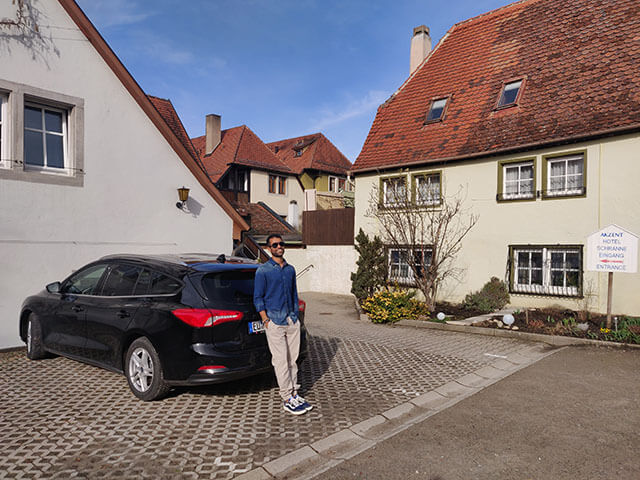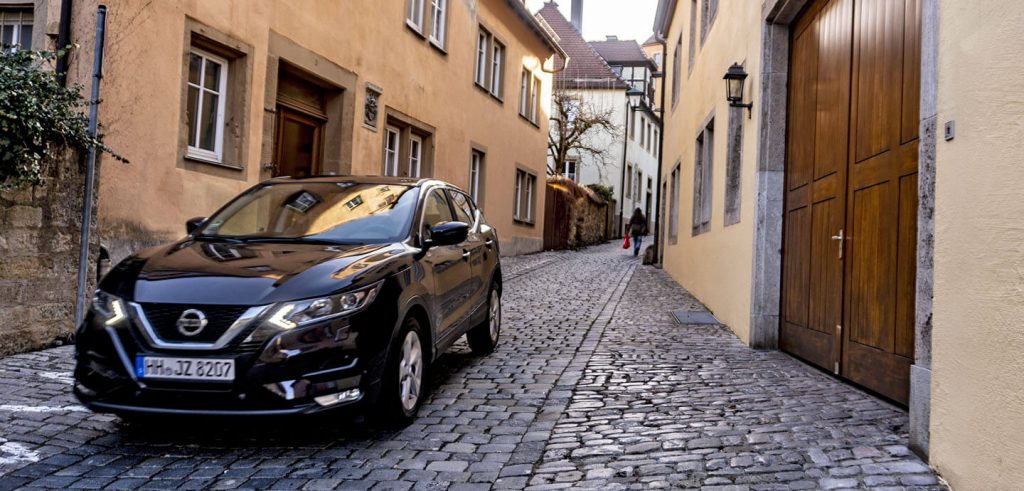Visiting Europe & planning to drive? Read these useful tips for renting a car in Europe, and save yourself some $$$.
During my recent blog trip with Germany Tourism, I ticked off a major bucket list thing — hiring a car and doing a road trip in Europe. Though it was a short one, the fact that it was my first attempt at solo driving in Europe, I was happy.
You can read about the journey here: A 7-Day Road Trip Across The Romantic Road In Germany
So if you are just as helpless as I was before the trip, and you have never rented a car in Europe before, this article is for you. These tips for renting a car in Europe will make even more sense if you happen to be an Indian renting a car in Europe. So, let’s start…
Tips For Renting A Car In Europe

Know The Hidden Costs
Driving around in Europe is a great experience. But there’s more to the deal than just a great experience.
Thanks to hidden costs that you figure out at the reception desk before your dealer hand-over the keys, renting a car in Europe can feel expensive. And that’s why knowing the hidden costs is the first thing to discuss in this list of tips for renting a car in Europe.
I remember when I was booking a rental car in Europe, online from India, I was so happy that I found an unbelievably cheap deal. According to the payment invoice, I booked a Ford Fiesta for 7 days for just 125 EUR in total (some 9500 Rupees). 3 days later, I flew to Germany, and the reception desk happened!
I presented the invoice at the reception desk of Buchbinder Car Rental at Frankfurt airport, and I was told that there are an additional 40 EUR taxes that are not mentioned in the invoice.
To make it worse, I was told that my agreement includes no insurance and has an 800 EUR excess fee. Meaning, a single scratch on the car would make me liable for 800 EUR straight. Another scratch, and another 800 EUR penalty. On top of that, they will hold 1200 EUR from my credit card as a security deposit (nearly one lakh Indian Rupees).
Though I understand, I was only liable for any damage done to the car, the very explanation of paying 800 EUR straight for even a minor scratch on the car’s body put me in a vulnerable situation. And what happened next? I insured my car for an extra EUR 140.
Well, that’s the kind of hidden costs your car rental company can smartly trick you into. They make you feel so vulnerable (at least Buchbinder Car Rentals at Frankfurt Airport did that to me) that you find no other escape but doing what you’re being told.
In the end, I paid an additional EUR 180 (140 EUR insurance and some 40 EUR of taxes) when my rental invoice, at the time of online booking, said, I have to only pay EUR 125 at the reception desk.
But all that said, hiring a car has its own perks. And when you’re travelling in a continent like Europe, with beautiful countryside drives, the perks become even better. It gives you greater freedom on your travels, allowing you to visit remote and beautiful locations that public transport may not take you to.
Having said that, renting a car, even if you’re as inexperienced as I was, or you’re coming from a country like India where car laws and driving habits are quite different, does not have to be a nightmare. Just read ahead and learn from my experience.
Also Read: Europe Budget Travel Tips
7 Most Common Mistakes
Choosing A Company
After my bad experience with Buchbinder, I shared about it in a couple of Facebook groups, and I found that many people had a similar experience with Buchbinder. It wasn’t a popular choice, after all.
Most people suggested major rental car companies in Europe, like Avis, Hertz, Budget, Europcar, and Sixt, over Buchbinder. A little research on Quora only assured the fact.
Avis, Hertz, Budget, Europcar, and Sixt, are the top players in Europe and are most people’s first choices. And since they’re big and reputed, the chances of them ripping you off with hidden costs are lesser.
To find the best deal, it’s a wise idea to check a price comparison website. AutoEurope.com, for example, is a great resource for finding out the best rates by comparing all the major players under one window. It’s something similar to what Kayak or Skyscanner does for flights.
The Driver’s Age Matter
Some of the rental companies charge a higher fee if the driver is younger than 25 years in age, at the time of car hire.
Though the legal age for driving is much younger, and you need to be only 21 to be able to rent a car in Europe, the rental companies charge a little extra if you’re young.
So make sure you look into the company’s younger driver policy.
Total Number of Drivers Matter
Another strange thing that I never expected could add a difference to the cost of your rental agreement is ‘the number of people that are going to be driving the rented car’.
For example, if you’re a squad of 4 friends renting a car, but only one person is going to drive throughout the trip, it’s fine. But if you told them (at the reception desk or while booking online) that there are 3 drivers out of 4, you will be charged 5-20 Euros extra for every extra driver.
The reason for the increase in the rental price is because of the number of people insured. If you’re one person driving, the rental agreement comes with one person’s insurance. If 4 people drive, the rental agreement comes with 4 people’s insurance.
The number Of Countries You’re Visiting Matter
When it comes to a rented car you pay an extra fee for every country you travel to. Some rental companies don’t even allow you to take the car to certain countries.
So, make sure you check your car rental company’s policy before you book with them. Enquire about how much it’s going to cost you extra. Compare the cost with a few companies and find the best deal.
Total Kilometres You’re Going To Drive
Unless your rental agreement says that you have ‘unlimited kilometres’, you are only allowed to do a limited distance. In most cases, it is less than 250km a day. If you happen to drive more than the daily allowance, you pay the fine. So double-check the company policy if you’re going to too many places.
Get Yourself An International Driving License
When you go to pick up your car you are asked for a valid Driving License. You will be happy to know that most countries in Europe allow you to drive with your home country license. Eg in my case, they allowed me to drive on my Indian driving license without asking for an international driving permit. But they can still ask to see your International driver’s Permit (IDP), particularly if your home Driving License is not in English. So get yourself an IDP.
It is moreover important to know that an IDP does not replace your Driver’s License but only supplements it.
In some cases, your travel insurance may also not be valid overseas if you’re driving with domestic insurance. So be careful and read your travel insurance terms. Or, get an international driver’s license to avoid surprises.
Also Read: Tips For Schengen Visa Travel Insurance
Dealing With Expensive Insurance
Lawfully, every car rental agreement in European Union countries comes with a ‘reduction of liability insurance. Under this, any damages to you or other vehicles, during an accident, are covered.
It doesn’t matter how cheap your rental agreement was, you’re going to get a third-party ‘reduction of liability insurance. It’s mandatory by law.
Now, your car rental company will most likely trick you in by providing a zero-depth cover on top. This can be 20 EUR per day extra. In my case, Buchbinder added EUR 140 to my rental agreement for a 7-day period. Standing at the reception desk with a long queue behind me, forcing me to act fast, and with no experience of how to deal with the situation and avoid the insurance, I did as I was told and ended up bleeding EUR 140. But there are quite a few ways to actually avoid the fee and still get zero-depth insurance.
How?
Many credit cards offer primary and secondary car rental insurance. Check if one of your credit cards has that too. If yes, use it to pay for the car rental and you are sorted. If not, there are quite a few third-party insurance companies in Europe that provide full or partial coverage of your car, at a much lower price.
Eg, iCarHireInsurance.com is a great option (PS: I am not being paid to advertise them!). I later checked that I was getting the same kind of coverage from iCarHireInsurance for around EUR 60 that Buchbinder provided me with for 140 EUR. See the difference?
Though iCarHireInsurance is indeed a third-party insurance company and any damages were to be first paid out of my pocket before I could claim the money, the chances of claiming insurance were very low. And the difference between the two similar insurance was huge!
Additionally, it matters which country you’re booking your car from. Eg a similar package in Germany may cost more than a similar package in France because of state taxes. So yea, be careful about that.
Renting A Car In Europe: Key Takeaways
- The same package in different countries can cost different because of local taxes.
- Don’t use Buchbinder, from my personal experience. Try to stick to reliable and bigger companies like Avis, Hertz, Budget, Europcar, and Sixt.
- Use comparison websites like AutoEurope.com
- Read the company rental policy for any extra fee for young drivers, number of km per day restriction and country restrictions (if you’re visiting multiple countries).
- Find a way to save on additional protection of your car insurance if you can.
If you have a question or would like to connect, please find me on Instagram. You can also follow my YouTube channel for video updates.



